One crucial skill every sea kayaker needs to develop is the ability to perform a self-rescue. While kayaking in high-risk conditions should be avoided whenever possible, knowing a variety of self-rescue techniques in case your kayak does capsize can be life-saving. Proper instruction and practice in self-rescue techniques dramatically reduce the risks associated with capsizing, contributing to a more enjoyable experience on the water.
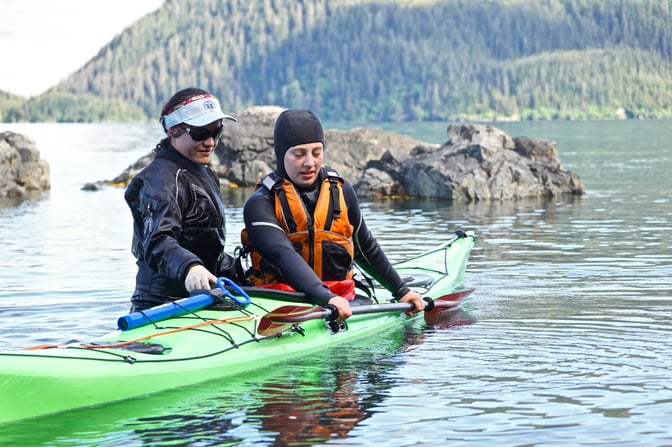 Photo by Devin Duffy
Photo by Devin Duffy
At NOLS, we believe that while proficiency in self-rescue is essential, having confidence in self-rescue techniques should never be used to recklessly push the boundaries of your skill set.
We emphasize hands-on practice in a controlled environment, focusing on risk management, personal growth, and leadership development. Our students learn these essential techniques in calm water and a controlled environment that minimizes unnecessary risks so that they can focus on skill acquisition.
This approach not only instills a sense of preparedness but also cultivates confidence, equipping students to navigate with assurance when faced with rougher conditions along the coastal waters.
Key Takeaways on Kayak Self-Rescue
- Proficiency in self-rescue techniques is crucial for all sea kayakers, but should not be relied upon to push one's boundaries recklessly.
- At NOLS, we emphasize structured, hands-on practice in a controlled environment for learning essential self-rescue techniques.
- Developing self-rescue skills contributes to personal growth, self-leadership, and risk management abilities in the world of sea kayaking.
Importance of Individual Recovery and Self-Rescue Skills
In the context of kayaking, "self-rescue skills" and "individual recovery skills" are often used interchangeably, as they both refer to the ability of a paddler to manage and overcome challenging situations on the water, like a capsize, independently.
Individual recovery and self-rescue skills are crucial for proper risk management and an enjoyable kayaking experience. These skills are employed to regain control, re-enter one's own kayak, or assist someone else after a capsize and wet exit.
During a NOLS sea kayaking course, we train you in these skills in a structured and intentional environment. We strive to provide an accessible learning experience for everyone, regardless of one's skill level at the start of the course.
Remember, the objective is to become proficient in these self-rescue techniques without relying on them to push your skillset's boundaries. By developing strong individual recovery skills, you can enhance your overall well-being and enjoyment during your kayaking experience, ultimately embarking on a transformative journey of personal growth.
Be Proactive: Avoiding High Capsize Potential Conditions
When it comes to kayaking with confidence, prevention is key.
Understanding the potential causes of capsizing is a key aspect of self and situational awareness. While adequately preparing for rough water and hazardous conditions can significantly reduce the risk of a capsize, doing your best to avoid such conditions whenever possible and paddling in a suitable environment instead is the way to go.
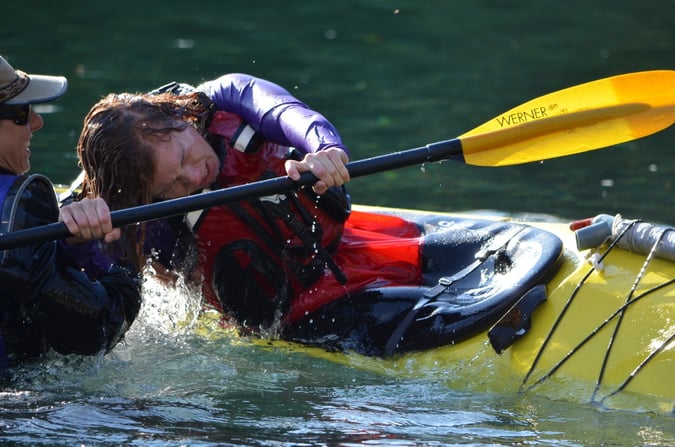 Photo by Jonas Alexandersson
Photo by Jonas Alexandersson
While preparing adequately for rough waters and hazardous conditions goes a long way in minimizing the risk of a capsize, the optimal approach involves steering clear of such conditions whenever possible and choosing a more suitable paddling environment.
If you or someone in your pod does capsize, view this instance as a valuable opportunity to reflect on whether the prevailing conditions surpass the group's capabilities. Once the capsized individual has been successfully rescued, proactively avoiding paddling in conditions with significant capsize potential becomes crucial. Debriefing incidents like this are key to risk management and increases the chances of an enjoyable kayaking experience for all involved.
Possible Causes of Capsize
Capsizing a kayak can occur for various reasons, some of which are easier to predict and avoid than others.
To build your risk management skills and be better prepared for your sea kayaking experience, it's important to understand some of the primary factors that contribute to capsizing, such as poor balance, turbulent water conditions, weather-related concerns, equipment-related issues, and human error.
Poor Balance
One common cause of a capsized kayak is poor balance. Sometimes loss of balance may occur while reaching for snacks or attempting to pee, while other times it may result from more significant challenges such as losing balance during launching or landing. Regardless, maintaining your balance while kayaking is crucial.
In particular, you should avoid leaning too far in any one direction, especially when a shift in your position could cause a sudden loss of balance. At NOLS, we practice balance and stability exercises that can help you gain confidence and reduce the likelihood of capsizing, as well as techniques for carefully and quickly regaining balance on the water.
Turbulent Water Conditions
Fast-moving currents, large waves, and even boat wakes can create an unstable environment for your kayak. In situations where capsizing could result from factors like rough seas, a broach while surfing, or getting caught in a current, having a practiced response becomes indispensable.
It's important to be aware of such conditions and adjust your risk assessment accordingly. Knowing what to expect in terms of water conditions and choosing routes that align with your skill level can help you avoid capsizing. Familiarize yourself with currents, tides, and water temperatures. Cold water can impact your ability to self-rescue and may require additional risk management precautions.
Weather-Related Causes
Similar to water conditions, weather can also contribute to a kayak capsizing. Wind and rain can have a substantial impact on your stability, your paddling efficiency, and the water conditions. Avoid paddling in strong winds, large waves, or storms whenever possible to prevent accidental capsizes. Pay attention to weather forecasts and make informed decisions for your paddling experience.
Equipment-Related Issues
Equipment-related issues can play a role in capsizing as well. It’s important to have your kayak properly fitted and adjusted to your body and skill level. A well-fitted kayak will provide you with a more secure and stable platform, making it easier to maintain balance and decreasing the likelihood of tipping over.
Human Factors
Fatigue, lack of focus, overestimating one's abilities, miscommunication, and even group dynamics can contribute to increased risk of capsize. Self-awareness is key. Knowing your limitations and developing the self-leadership skills to "call it" when you're feeling tired or unfocused is a huge part of the NOLS curriculum. During our sea kayaking courses, students take the time to practice their kayaking skills with an additional focus on developing self-awareness, self-leadership, and teamwork with the goal of creating proactive responses to these human factors.
Here are a few proactive risk management tips to follow:
- Always wear a properly fitted PFD/lifejacket to aid in buoyancy and self-rescue.
- Use a helmet in rough or rocky conditions to protect your head.
- Dress appropriately for the water and air temperatures to maintain comfort and body warmth; drysuits might be appropriate when paddling in cold water.
- Keep a paddle float and a bilge pump handy for self-rescue situations.
- Carry a VHF radio on your PFD. We recommend a model that floats and has a strong waterproof rating.
At NOLS, we emphasize the importance of effective communication between paddlers. Carry a whistle, and make sure you understand basic hand signals to communicate with others in case of emergencies.
By being proactive and considering the factors mentioned above, you can minimize the potential for capsizes and focus on enjoying your time on the water.
Sea Kayak Self-Rescue Training with NOLS
Our sea kayaking courses include structured and intentional training sessions that help you develop these skills in a managed environment, without taking unnecessary risks.
A Controlled Environment
During a NOLS sea kayaking course, students practice self-rescue techniques in a "classroom" of calm water. This intentional setting reduces the likelihood of drift, allowing students to concentrate on mastering the skills at hand first, rather than being preoccupied with assessing the hazardous conditions of rough water.
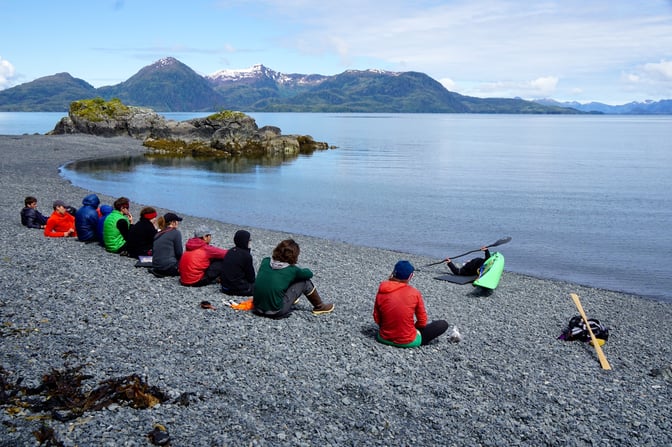 Photo by Devin Duffy
Photo by Devin Duffy
Seasoned Instructor Guidance
With a keen eye for risk management, our seasoned sea kayaking instructors set students up for effective self-rescue clinics, guiding them through potential hazards, assessing external forces, and monitoring skill levels for effective coaching and feedback.
The number of instructors present depends on the specific training activity and the group size. However, in many cases a single instructor on the water is sufficient for rescue practice with 2 to 4 student boats, assuming that only one boat is inverted at a time. Additional instructors may be necessary for comprehensive support when unique challenges are present in the practice waters. In cold settings, beach-based instructors oversee student warm-ups, and in poor run-out scenarios, another stands ready to catch drifting students, contributing to a focused and secure learning experience.
Self-Rescue Skill Progression with NOLS
Through consistent practice and training focusing on intentional skill progression, you will enhance your self-rescue proficiency and strengthen your paddling skills and overall understanding of risk management. As a result, your confidence in kayaking will grow, allowing you to enjoy this mode of exploring remote coastal locations to the max. As you gain experience in kayaking, your ability to assess and mitigate risks will also develop.
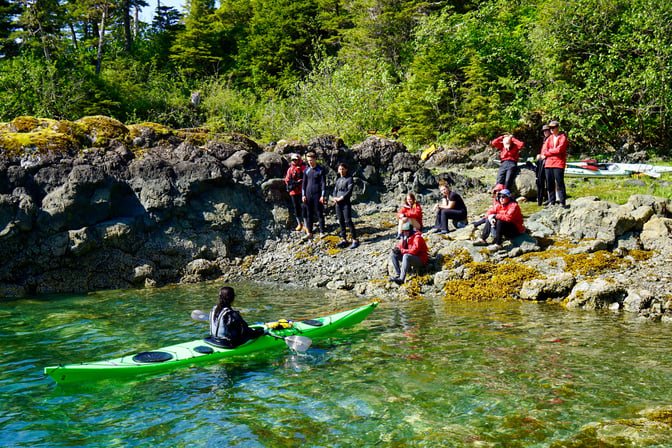 Photo by Devin Duffy
Photo by Devin Duffy
First Days: Building Foundations for Kayak Resilience
The initial days of a kayaking course are foundational, setting the tone for the entire learning journey. During this phase, our instructors introduce you to critical skills, like wet exit and re-entry techniques, that form the backbone of your ability to handle unexpected situations on the water.
Wet Exit
The wet exit is a fundamental maneuver that empowers students with the ability to effectively exit a kayak in water. This skill is crucial for scenarios where capsizing is inevitable, whether due to turbulent waters or unexpected obstacles. Having the ability to confidently exit your kayak is essential for your risk management strategy.
Emphasis is placed on proper body positioning, efficient removal of the spray skirt, and controlled movements to avoid entanglement. Instructors guide students through step-by-step instructions, fostering confidence in their ability to handle unexpected situations right from the outset.
Once out of the cockpit, you can attempt a re-entry using a paddle float or the T-rescue method. Students learn to maintain composure, stay calm, and execute a controlled wet exit, contributing to a smooth transition from being enclosed in the kayak to the open water.
Re-Entry/Re-Boarding Techniques
After becoming proficient in the wet exit, students progress to the re-boarding technique, a key skill for autonomously getting back into the kayak after a capsize or wet exit.
This phase emphasizes the importance of maintaining control over the kayak while re-entering, increasing stability, and reducing the risk of a re-capsize.
Our instructors introduce a reliable re-boarding method, emphasizing a step-by-step approach that includes grabbing the cockpit rim, stabilizing the kayak, and gradually sliding back into the cockpit. This skill is particularly vital in situations where a wet exit may not be the best option, such as cold water environments or when the kayak remains afloat after capsizing. Through repeated practice, students develop muscle memory and confidence in their ability to regain control of the kayak.
Unassisted Double Re-Entry
While it's important to note that single-assisted rescue is not recommended early in the course because students need to first gain proficiency in essential boat control skills, particularly an effective draw stroke, the first days of the course do include practicing a double re-entry without assistance.
This unassisted double re-entry not only enhances individual skills but also fosters teamwork and mutual support among participants. It reinforces the idea that kayakers should be self-reliant in managing unexpected situations. By navigating the challenge of re-entering the kayak without external aid, students gain a deeper understanding of their own capabilities and limitations, laying the groundwork for more advanced rescue skills later in the course.
The first days of a NOLS sea kayaking course go beyond skill acquisition. They instill a mindset of resilience, self-reliance, and confidence in the face of the unpredictable nature of the water. These foundational skills form the basis for the progressive learning journey that follows, preparing students for the more advanced challenges that kayaking may present.
First Half of the Course: Advanced Re-Entry Techniques
As students progress through the initial stages of their kayaking course, they transition from foundational skills to more advanced techniques that enhance their ability to handle challenging situations on the water. The focus during this phase is on building stability and refining re-entry methods.
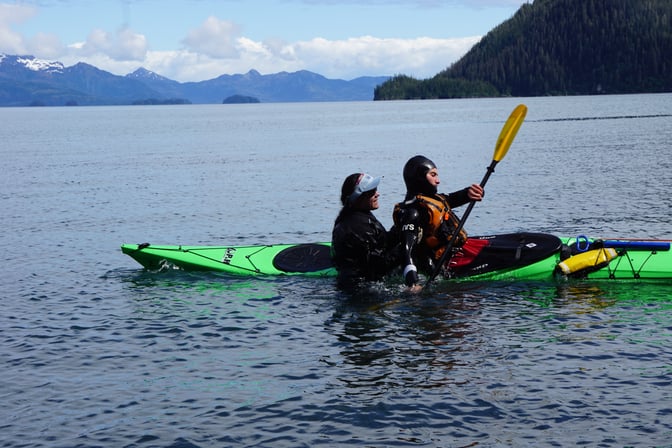 Photo by Devin Duffy
Photo by Devin Duffy
Paddle Float Self-Rescue
Introducing the paddle float reentry is a pivotal moment in the kayaking course. This technique involves attaching an inflatable float to the paddle blade, providing additional buoyancy and stability as you re-enter the cockpit of the kayak. By incorporating the paddle float, kayakers can regain control of the kayak with enhanced stability, making it particularly useful in challenging conditions or for those still building confidence in unsteady waters.
After securing a paddle float to one end of your paddle, use the paddle as an outrigger to provide stability while reentering the kayak.
Place the paddle perpendicular to the kayak with the paddle float in the water, holding the paddle shaft against the back of the cockpit.
Next, kick your legs to get your body horizontal on the surface, then slide onto the rear deck with your chest facing down.
Lastly, twist your body and swing your legs into the cockpit, maintaining contact with the paddle for support.
Our instructors guide you through the proper use of the paddle float, emphasizing the importance of maintaining balance and control throughout the re-entry process. This technique not only boosts individual confidence but also serves as a foundation for more complex rescues down the line.
Cowboy Scramble Self-Rescue and/or Cross-Cockpit Lunge
Soon after the first few days of the course, instructors introduce the cowboy scramble and/or cross-cockpit lunge, advanced re-entry techniques designed to enhance stability in varying conditions. These methods involve alternative approaches to re-entering the kayak, providing kayakers with a broader skill set to adapt to different scenarios.
The cowboy scramble involves flipping the boat upright and climbing back in from the side in a straddle position, similar to mounting a horse ("cowboy style").
The cross-cockpit lunge entails sliding across the cockpit while maintaining balance, ultimately achieving a stable re-entry.
These techniques not only improve stability but also encourage students to become adaptable and creative in their problem-solving on the water. Instructors guide students through the nuances of each technique, emphasizing the importance of maintaining control and composure during re-entry.
Single Assisted Re-Entry
While the single assisted re-entry is a valuable skill, it is strategically reserved for later in the first half of the course. This decision is rooted in the recognition that students need to develop robust boat control skills before attempting this more complex rescue technique.
The single assisted re-entry involves one kayaker assisting another in re-entering their kayak. This assistance can come in the form of stabilizing the overturned kayak or providing support as the participant re-enters the cockpit. It requires a nuanced understanding of boat dynamics and precise coordination between the rescuer and the one being assisted.
By delaying the introduction of the single assisted re-entry, our instructors help students hone their boat control skills, including mastering effective draw strokes. This foundation is essential for timely and efficient assistance during a rescue scenario. Waiting until this point in the course allows students to approach the single assisted re-entry with greater confidence and competence, setting the stage for successful execution.
Mid-Course and Beyond: Elevating Skills with Essential Techniques
As our kayaking enthusiasts progress into the mid-course and beyond, the focus shifts towards introducing advanced techniques that add layers of proficiency and versatility to their repertoire of skills. This stage is crucial for refining rescue abilities and fostering a deeper understanding of the intricacies of kayaking in diverse conditions.
Any Time, as Student Interest Warrants: Tailoring Learning to Enthusiasm
The beauty of kayaking lies not only in its technical aspects but also in the diverse interests of participants. Therefore, the mid-course and subsequent sessions offer the flexibility to explore advanced rescues based on individual student interest. This personalized approach to learning allows students like you to remain engaged and motivated throughout their kayaking journey.
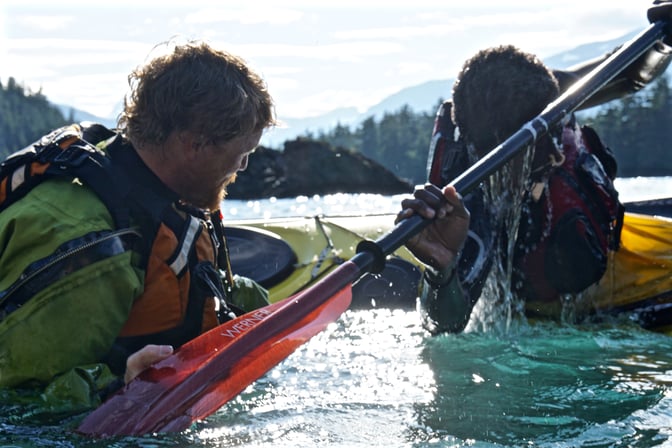 Photo by Devin Duffy
Photo by Devin Duffy
The Roll: Self-Rescue Mastery
Introducing the roll marks a significant milestone in a kayaker's journey. This self-rescue skill involves righting a capsized kayak using a specialized rolling technique. Instructors guide participants through the step-by-step process, emphasizing the importance of body mechanics and paddle control. The roll empowers kayakers to regain control of their kayak independently, enhancing their confidence in more challenging environments.
Rolling is a traditional and effective method of self-rescue. Exploring these advanced rescues allows participants to delve into the traditional techniques of righting a capsized kayak without leaving the cockpit.
This technique involves a series of coordinated movements such as hip snap, body tuck, blade control, and head positioning to right your kayak after capsizing. Mastering a roll requires consistent practice drills and a focus on maintaining proper form at each step of the process.
Instructors guide students through the intricate motions of a roll, emphasizing the importance of proper technique and body positioning.
Scoop/Hand of God: Assisting Others with Precision
Learning the scoop or Hand of God technique are both valuable additions to a kayaker's skill set. These techniques involve helping another capsized paddler by reaching out and providing support, either by grabbing the PFDt or the kayak itself. Instructors focus on the importance of precise timing and coordination to execute the rescue effectively.
Towing: Navigating Challenges Together
Understanding the essentials of towing is fundamental for any kayaker venturing into more dynamic waters. In this phase, participants learn how to tow other kayaks, developing an understanding of the equipment and techniques needed for effective assistance. Towing skills enhance the kayaker's ability to navigate challenging conditions and support fellow paddlers when needed.
Re-enter & Roll: Comprehensive Self-Rescue
Combining re-entry and rolling skills in the re-enter & roll technique provides a comprehensive approach to self-rescue. This advanced skill allows paddlers to seamlessly transition from being in the water back into the kayak using a rolling motion. Instructors work with participants to refine their technique, emphasizing the importance of fluidity and efficiency in execution.
The mid-course and subsequent sessions in a kayaking curriculum offer a dynamic blend of essential techniques tailored to individual interests. From mastering stability with the paddle float re-entry to exploring advanced rescues based on student enthusiasm, this phase lays the groundwork for kayakers to navigate the waters with confidence, proficiency, and a deep appreciation for the intricacies of their chosen adventure.
Start Your Journey Toward Sea Kayak Self-Rescue Confidence
Eager to gain sea kayak self-rescue confidence? Explore the sea kayaking expeditions that we offer!
Our comprehensive courses provide not only essential technical skills but also a mindset of resilience, adaptability, and risk management. Proficiency in self-rescue techniques is a crucial aspect of sea kayaking, and we believe in empowering our students with the knowledge and hands-on practice needed to navigate unpredictable waters.
By enrolling in a NOLS sea kayaking course, you're not just learning to paddle, you're immersing yourself in an experience that goes beyond the basics of sea kayaking for beginners. Our seasoned instructors guide you through a carefully structured progression, from foundational wet exits to advanced Eskimo rescues and comprehensive re-enter & roll techniques.
Frequently Asked Questions
What are the essential self-rescue techniques for sea kayakers?
At NOLS, we stress the importance of being proficient in essential self-rescue techniques for sea kayakers. These techniques can be critical in managing risks while kayaking, and some of the key methods include the wet exit, paddle float rescue, and the cowboy rescue. By practicing these skills in a controlled environment, you can gain a better understanding of risk management and develop your ability to respond effectively in various situations.
How do you perform a paddle float rescue in a sea kayak?
A paddle float rescue is a technique for reentering a capsized sea kayak. First, secure a paddle float to one end of your paddle, and then use the paddle as an outrigger to provide stability while reentering the kayak.
Place the paddle perpendicular to the kayak with the paddle float in the water, holding the paddle shaft against the back of the cockpit. Next, kick your legs to get your body horizontal on the surface of the water, then slide onto the rear deck with your chest facing down. Lastly, twist your body and swing your legs into the cockpit, maintaining contact with the paddle for support.
What is the T-rescue method in kayaking?
The T-rescue method involves a collaborative effort between two kayakers—one capsized and one providing assistance. The rescuer positions their kayak perpendicular to the capsized kayaker's boat, forming a T-shape. This configuration provides stability and a secure platform for the capsized kayaker to re-enter their vessel.
What is the X-rescue method in kayaking?
The X-rescue is a technique used when two kayakers need to assist each other in reentering a capsized sea kayak. The assisting kayaker stabilizes the capsized kayak by placing their bow over the stern of the capsized vessel, forming an "X" shape with their kayaks. The person in the water then empties the capsized kayak by pulling it across the stabilizing boat, flips it right-side up, and reenters the kayak, with the help of the other paddler. For a detailed demonstration of the X rescue, watch this instructional video.
How do you use rescue straps in a kayak self-rescue?
Rescue straps, also known as paddle rescue straps or paddle leashes, can be used in a kayak self-rescue to keep your paddle within reach or as a temporary outrigger for support. Some paddlers also use rescue straps to secure their paddle to the kayak while reentering the kayak, similar to the paddle float rescue. To use rescue straps effectively during a self-rescue, you must practice attaching and detaching them quickly and efficiently. Make sure to follow manufacturer guidelines for proper use of these versatile accessories.
What is the heel-hook technique for kayak self-rescue in deep water?
The heel-hook technique is a deep water self-rescue method, which helps you reenter your kayak without using a paddle for support. First, orient yourself with your back to the kayak and your legs parallel to it. Then, with your hands on the far side of the cockpit, hook the heel of one leg on the cockpit edge closest to you. Next, use your heel to pull your body onto the rear deck, keeping your weight low and center. Finally, twist your hips and slide your legs into the cockpit while holding onto the opposite edge for stability. Watch this video for a visual demonstration of the heel-hook technique.
How can one perform a cowboy rescue in a sea kayak?
The cowboy rescue is a kayaking self-rescue technique where you reenter your kayak from the stern end (opposite the bow) instead of the side.
First, position yourself at the stern end of your kayak, holding onto the grab loop or handle. With your chest facing down, kick your legs to gain momentum, and then slide your chest and torso onto the stern deck.
Now, straddle the kayak in a seated position, keeping your weight low, and slowly work your way towards the cockpit. Finally, slide into the cockpit, being cautious not to capsize the kayak. This technique requires practice and balance, so make sure to master it in a controlled environment before using it in real-life situations.
Written By
NOLS
NOLS is a nonprofit global wilderness school that seeks to help you step forward boldly as a leader.



